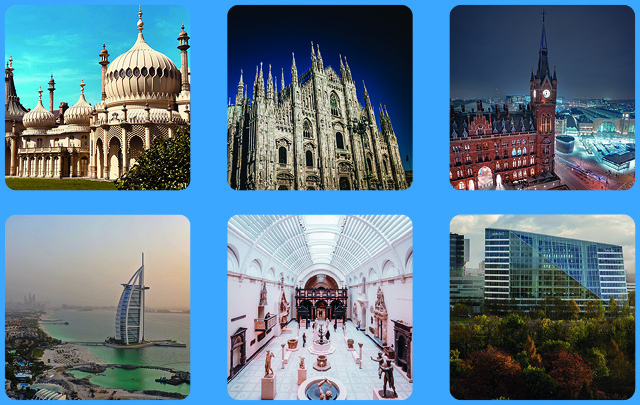Last week we started our favourite building series, where we asked the MRG team to pick their favourite building. This week we are travelling from Brighton to Dubai, with buildings ranging from modern smart builds to renaissance classics.
Royal Pavilion, Brighton
As many people know I grew up in the Brighton area and have always been fascinated by the former seaside retreat of King George IV. Construction started in 1787 and was completed in 3 phases.
The Pavilion was built in the Indo-Saracenic style, which is rarely seen in the UK. Its current appearance with its domes and minarets, is the work of architect John Nash (responsible for other well-known buildings such as Marble Arch and Buckingham Palace), who extended it in 1815. In 1850 the Pavilion was sold to the city of Brighton by Queen Victoria, for £50,000. It was used as a military hospital site during World War One and in modern times has a number of uses including as a museum, wedding venue and conference facility.
Duomo Di Milano, Italy
At the centre of Italy’s iconic city of Milan an impressive building standing over 100meters tall attracts the attention of all that pass. With culturally rich gothic architecture, it was created in the early 1300’s during the renaissance period. The construction was no small feat, with over 130 spires composing of brick and marble. The level of complexity for this construction focussed on the skill and expertise of experienced professionals, reliant on their hands and simple tools to guide them.
I picked Duomo Di Milano as my favourite building, as it is a beautiful building in a culturally rich city, where fond memories have been made. It’s a great demonstration of creativity by design, over technological advancement.
St. Pancras Renaissance Hotel, London
Ever since I was 9 years old watching Harry Potter and the Chamber of Secrets, I’ve always loved the St. Pancras Renaissance Hotel and can’t help but look up at its beauty every time I walk past. The building was first opened in 1873 as the Midland Grand Hotel, which was designed by George Gilbert Scott. This was the only hotel Scott ever worked on, he was actually known for designing hundreds of churches, cathedrals and chapels – that influence can definitely be seen in the overall design of the building.
It is widely known as an architectural Renaissance masterpiece, however the building was almost demolished in 1967. Luckily Sir John Betjeman saved the hotel by circulating a petition and getting it a Grade 1 listing.
I’ve never stayed at the hotel, but I have had Afternoon Tea there before and the interior is just as beautiful as the exterior. If you’re ever in the area I recommend popping in for a look around.
Burj Al Arab, Dubai
By Henry Tye
The Burj Al Arab is one of the most iconic structural buildings in Dubai; standing 321 metres tall, it is 14 metres taller than the Eiffel Tower. This unique building took 5 years to build and is located 280m offshore on a man-made island.
As a keen sportsman the building poses an impressive heli pad where numerous sporting stunts have taken place. In 2004 Tiger Woods was seen teeing off the platform and a year later Andre Agassi and Roger Federer took part in an exhibition match on a makeshift tennis court.
V&A Museum, London
By Leena Lais
My favourite building is the V&A Museum, it’s a building immersed in cultural history. Each aspect of the building is designed to promote contemporary (at the time) architecture and design. When I was studying in London, the museum was a great place to spend my days and I was always in awe of the sheer enormity of the building, what is incapsulated for the Arts and Culture, and how it provided accessibility to educate the mass on arts & culture.
The Edge, Amsterdam
The Edge in Amsterdam is hailed as one of the smartest buildings in the world. This building is so smart it knows where its occupants live, what they drive, and even how they take their coffee. Powered by a central dashboard and approximately 28,000 sensors, this genius property tracks everything from energy use to when breakroom supplies need replenishing. Tenants and employees use a smartphone app that checks their schedules, locates their colleagues, books a desk or space for focus work, and directs them to a parking spot when they arrive at the building. Other key features include a smart air-flow design and system, rainwater reclamation, solar panels, charging areas for electric vehicles, and bike parking which drive the The Edge’s sustainability initiatives. Technology and gigabits of data and insights make this building smart enough to shut down entire sections that aren’t being used—drastically reducing energy consumptions. It even stores your exercise / gym workout data to be sent back to you when you use the machines at different stages of your regiment. It’s amazing!
Missed Week 1? You can read all about it here.
Missed Week 3? You can read all about it here.
Missed Week 4? You can read all about it here.
Missed Week 5? You can read all about it here.
Missed Week 6? You can read all about it here.
